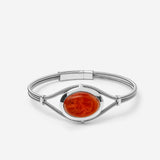SASANIAN GLYPH BRACELET IN SILVER
ORIGINAL ANTIQUITY
ANCIENT · MIDDLE EAST
We attend all our customers personally. Please leave us your contact details for information and sales.
We attend all our customers personally. Please leave us your contact details for information and sales.
DESCRIPTION
ORIGINAL SASANIAN RING-STONE SEAL (224-651 AD) · We have set the 1500 year old Persian artifact in sterling silver, mounted on a stainless steel wrist cable. Each bracelet is custom adapted to your wrist, we will contact you to assure the perfect fitting.
This ancient piece of miniature art is shaped into a contemporary object of identity. It features the original carnelian seal on the outside with its detailed print, cast in silver on the inside.
-
Original Sasanian ring-stone seal in carnelian
-
Cable length custom adapted to your wrist size
-
Sterling silver setting
-
Seal print stamped by hand
-
Sterling silver clasp
-
Stainless steel wrist cable

SASANIAN RING-STONE SEALS (224-651 AD)
The Sasanian Empire was the last of the three great Persian empires that dominated Western Asia for more than a thousand years:
-
Achaemenid (Persian) Empire (550-330 BC)
-
Parthian Empire (247 BC - 224 AD)
-
Sasanian Empire (224-651 AD)
Personal seals became a mass medium during the Sasanian period, worn by all classes of society. They were used as tools for identity, symbols of personal belief, as well as decorative jewelry.
Sasanian seals are split into two distinct categories of shapes:
-
70% hemispherical, ellipsoid and conoid stamps
-
30% flattened ring-stones
The wide variety of stones and colours reflects the abundance of geological sources all over the Iranian plateau: carnelian, chalcedony, jasper, crystal rock,…
Seal depictions fall into three main groups:
-
Male portraits (bearded Persian men)
-
Single animals (lions, rams, antelopes, birds, scorpions)
-
Mythological creatures (griffins, human-headed winged bulls)
Sasanian seals come in a wide range of stones, featuring many different depictions. Here under you find a public reference in carnelian, together with examples of the three main types of representation:
-
Mythological creatures (winged bull)
-
Male portraits (bearded Persian man)
-
Single animals (bird)




-
K. Duistermaat, On the development of Sasanian seals and sealing practice
-
N. Ritter, Gemstones in pre-Islamic Persia: social and symbolic meanings of Sasanian seals
We acquired a large collection of ancient Western Asian seals at an auction house in Vienna, previously part of the Zelnik Istvan Southeast Asian Gold Museum in Budapest. Closed in 2013, the museum hosted one of the largest private collections of ancient Asian art. Authenticity and origin have been additionally established by V. G. E., an independent licensed antiquities expert.






